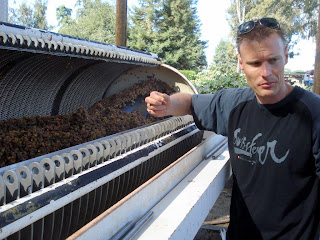

Even though Borra’s winemaker, Markus Niggli, didn’t think flavors were optimal, he called in the crew to save the grapes from over-cooking and preserve delicate flavors by picking them last Thursday.
In the cool of the morning, almost three-quarters of a ton were harvested and delivered to the winery in two bins with grapes at a nice 50˚. (By contrast, I was picturing a line of trucks carrying 20-ton grape loads waiting to be weighed-in at Woodbridge Winery.)


Since he’d be getting a smaller load than expected – now a common observation with the 2010 harvest – he deviated from his normal procedure by “chaining” his crush equipment together.


Rather than dumping all the whole clusters directly into the wine press, Markus hoped to get more juice from the batch by first crushing and destemming the grapes and then immediately spreading the crushed grapes into his press.


Such an unusual set-up meant that his two-man crew of Federico and Platon would spend more time getting the equipment ready and cleaning up afterwards than on the actual crushing of such a small quantity of grapes. These small lots drive cellar crews crazy, feeling like they didn’t accomplish much for all their work.
Pre-crush, the Gewürz tasted, “Sweet. With a floral aspect,” said Markus. The sugar came in at 23˚ Brix, with acid at 3.7 pH and lots of berries showing a reddish tint.


As we watched the juice cascade from the slats in the bottom of the press like rain from a cloudburst, Markus said he would have preferred the sugar to be at 26˚ Brix, but didn’t have a problem with this white wine grape being red, “With Gewürz we want red berries, actually. The green berries are not really ripe enough. That’s why the juice is so dark.”


With quality control in mind, I grabbed two wine glasses from the lab and scooped up enough juice collecting in the pan under the press to get a good taste. Markus assessed, “Slightly green. Tannins are there. TA is low. 3.75 pH. Will need acid. If I get a barrel and a half, I’ll be happy.”
“Need acid,” means Markus will add tartaric acid early on to balance the sweetness and help preserve the wine at a pH closer to 3.4.
The nearly-empty press was rotated and inflated up to about 0.8 bar of pressure before it became clear that we weren’t going to get more juice out of this batch, which barely filled the bottom of a 500 gallon tank.
50 parts per million of sulfur dioxide were added to the sweet brownish juice to kill off unwanted yeasts and bacteria before the cube-shaped tank was forklifted into Borra’s refrigerated container for a three-week cool fermentation.
Provided the Gewürz turns out nicely, “I hope to be able to put it into the White Fusion again this year as 3-10% of the blend,” said Markus.








































